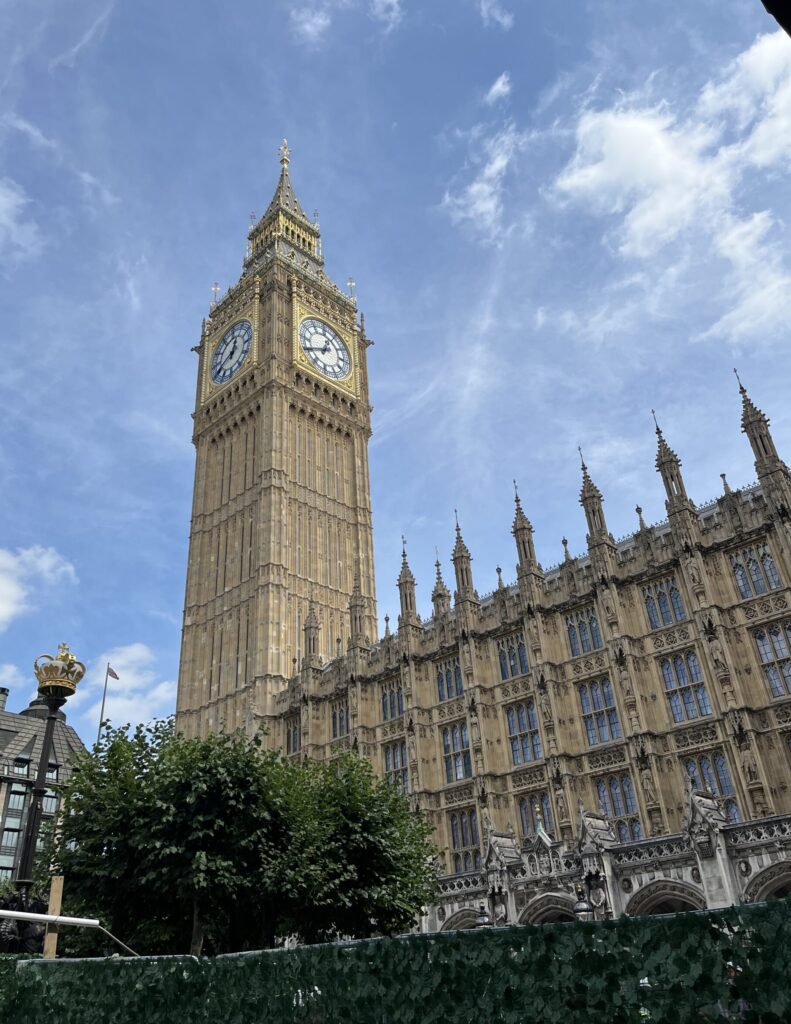In the heart of London, the Palace of Westminster is the beating heart of British democracy and a place where laws are debated and history is made. The Members of Parliament (MPs) hold the power to shape the UK and impact future generations. As the River Thames rushes past, it is also a spectacular piece of architecture that has witnessed the rise and fall of political leaders and events that have shaped British life. Members of the public have the ability to walk up to Parliament’s gates and lobby their MPs and have the opportunity to observe Parliament when in session. Tours of the Palace of Westminster run every Saturday but in August, when Parliament is in recess, the House of Lords, the House of Commons and Big Ben (Queen Elizabeth II Tower) are open to public tours during the weekdays. Visitors need to book a ticket for a specific tour. Tours are either guided or self guided with an audio guide. I attended the House of Commons with the House of Lords guided tour which included Westminster Hall, Central Lobby, The House of Commons Chamber and The House of Lords.

Right from the start, the Houses of Parliament are visually stunning from Westminster Bridge overlooking the River Thames. The House of Commons is frequently shown on the news with debates, the opening of state and is the place to look when there are big events domestically and internationally. Once through security, visitors are guided into Westminster Hall, where gold plaques on the floor signify the spot where significant events took place such as the lay in state of Winston Churchill, Queen Elizabeth II and other notable figures. While other plaques signify trials such as Thomas More. Interestingly, the ceiling is made of English Oak and is carefully crafted so each piece slots together like one giant jigsaw, without the need for nails or bolts, which is both incredible but also slightly terrifying.
From here, visitors are taken through to the Central Lobby and I immediately recognised the domed room from the news where politicians have been interviewed during ‘Live from Westminster’ broadcasts. I was also surprised to learn that this area is also home to a post office. What stood out the most was the level of detail in the architecture and the statues that celebrate British political history and the majority of the rooms and architecture is unchanged from when it was first built. It doesn’t take much to imagine past politicians and monarchs walking those halls and the all the debates and laws that have been created and overturned for over a hundred years. One room which was particularly interesting was the ‘Robing Room’, which the head of state will use during visits and most importantly the ‘Opening of Parliament.’ I thought it was very interesting that the carpet is blue that signifies the specific rooms that the current monarch can enter. They cannot enter the House of Commons, only the House of Lords. What is tragic is that the architect and designer Charles Barry and Augustus Pugin both died before the completion of the Robing Room and other spaces, and it remains unfinished regarding their original vision. It was also fascinating the learn that different rooms carry different themes, the Robing Room for example, is Knights of the Round Table themed and carry all the values that the Legend of King Arthur discusses.
Walking through the House of Lords Chambers and seeing the frescoes of the Battle of Waterloo and the Battle of Trafalgar and the intricate details was a massive highlight. Especially to learn about the lengths the artist went to interview survivors of both battles to help create as much depth and emotion as possible. As I walked through the rooms, I was in awe of the architecture and the preservation of previous political figures and heads of state. I loved seeing the paintings of the Tudor and Stuart dynasty that plots a massive turning point in Parliament and the uncertainty of the time period. The House of Lords was also spectacular with 23 carat gold – leafed throne, the iconic red seats and little animals carved into the wood were awe-inspiring. The tour also detailed the process of approving a bill or how debates worked with the consent corridors, the creation of Hansard records and the role of the whips. Finally, the tour finished with, in my opinion, the main attraction – the House of Commons. This is a room which most people will associate with British politics and is the heart of policy making and debates. The iconic green seats and the speaker’s chair are all elements that actually look at lot bigger on television than in person.
Overall, a really interesting tour, albeit slightly long at roughly 90 minutes, but more than worth the time when learning about the intricacies of government and the history that has helped create and carve the Parliament and the society that we live in today. I did feel at times, the tour sanitised history or brushed over key events, but there is a lot to cover in such a short amount of time. I would have loved to see some of the ceremonial dress that is used during the Opening of State or some of the state rooms. But, despite this, a really in-depth tour and look at one of London’s most famous and important building. The legacy of figures, designers and monarchs imperative to British politics are preserved in the walls and as history is constantly being made in the chambers, the building is also a reminder of the past that has already happened. The architecture reflects the changing values of each time period and the people, while also continues to add another layer into the history books.
Stay updated
Amy is a writer and reviewer and her action-packed debut novel, CORNELIA FAIRFIELD AND THE DARKENED HEART is set to be published in 2026! For more content click here to read book reviews, short stories and updates on Amy’s writing journey.
Don’t forget to follow Amy on TikTok, X and Instagram.

Sign up to Amy's newsletter for exclusive content, updates and reviews!

